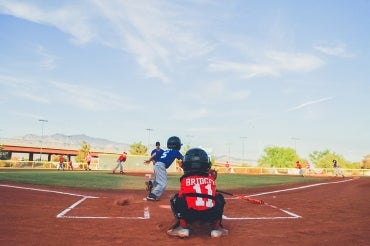Children busy with active sports schedules still find time to play: U of T study

Published: July 12, 2018
Are children’s busy schedules depriving them of their childhood and the ability to play freely? Not really, says a U of T study.
Researchers at U of T's Faculty of Kinesiology and Physical Education (KPE) worked with colleagues at McMaster University on a study, published in the Medicine & Science in Sports & Exercise journal, that found children with higher participation in organized sport and physical activity were engaging in greater free play, over time.
“Given the importance of free active play to development, it is reassuring to see that participation in organized sport and physical activity does not negatively affect discretionary active play,” says John Cairney, a professor at KPE. “Our results show that although participation in active free play peaks at approximately age 12 and then declines to age 14, children who participate in organized sport and physical activity maintain a higher level of active free play relative to their peers who are not involved in these organized activities.”
Over a five-year period, the researchers followed 2278 children moving through Grades 5 to 8 using a self-reported sport and physical activity questionnaire. They also looked at whether age, sex and socioeconomic status played a role.
They believe a possible explanation for this association may be related to the role sport plays in supporting physical literacy and the development of fundamental movement skills, allowing children to participate in more active play pursuits in their free time.
“The relationship between organized sport participation and positive youth development is well established,” says Cairney, the lead author of the study. “In addition to the psychosocial benefits, organized sports participation is linked to health-related outcomes such as improved metabolic health and bone mineral density, and improved nutritional habits, including increased fruit and vegetable consumption.”
Children and youth participating in free, active play are also given opportunities to be creative, learn to organize games in the absence of adults or specific rules, and develop or alter physical activity experiences in a variety of ways and settings, researchers say.
“Organized sport and physical activity often involve a skill development component, where fundamental motor skills are practiced and reinforced,” says Cairney. “Because children do not naturally acquire many of these skills, the acquisition and reinforcement of a range of these skills through structured experiences may provide the foundational skills necessary to facilitate participation in a broader range of discretionary activities in children.”
Kelly Arbour-Nicitopoulos, assistant professor at KPE and co-author of the study, says another explanation could be that children who are naturally inclined to be active “simply participate in a wide variety of activities, some organized and others discretionary.”
The researchers found the positive effect of sport participation on free play to benefit both sexes, although the effect is marginally better for boys than for girls. On the other hand, sex and socioeconomic status are among the most important barriers to children’s participation in organized sport.
“Removing structural and social/cultural barriers to organized physical activity participation is important for participation in sport and may also help to support active free play,” says Arbour-Nicitopoulos. “This should be a priority for policy-makers, communities and parents.”
Researchers also found indirect evidence against early specialization in a single sport or physical activity. Cairney says the study shows that the pursuit of multiple sports and physical activities, rather than a single activity, encourages active play in children.
The study was supported by the Canadian Institutes of Health Research.



